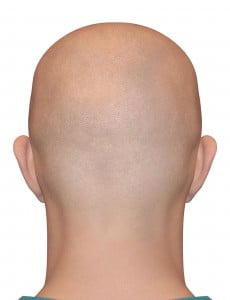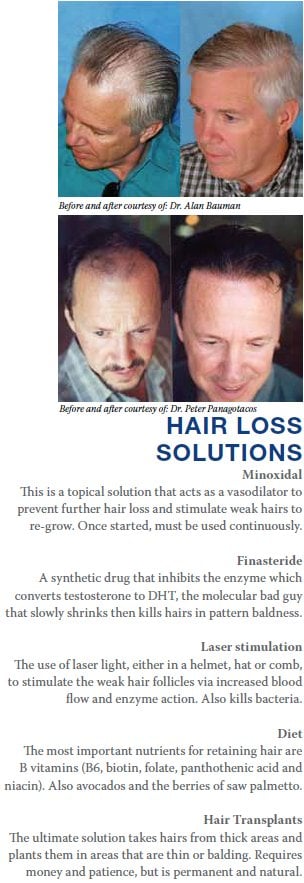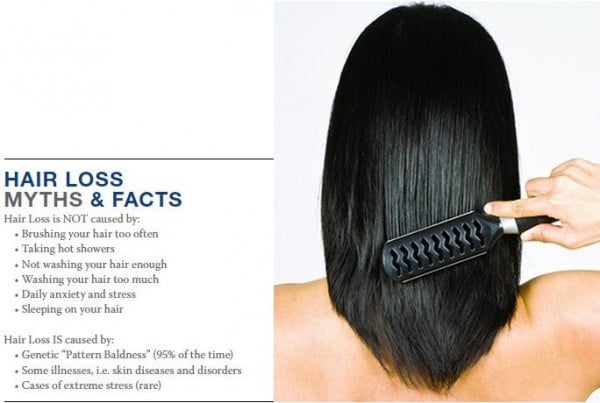

It is the dream of balding men (and women) everywhere: To get back that thick, youthful head of hair that’s been lost to the cruelties of age and time.
Like millions of other middle-aged Americans who have experienced pattern baldness, John Waterson remembers the signs: Hair accumulating in the shower drain; the cowardly retreat of his hairline; the appearance of that naked circle of skin on the back of his head, the so-called ‘monk’s’ bald patch.
“One day I just realized I wasn’t me anymore. I wasn’t the boy wonder anymore,” says Waterson, an engineer who lives in Maryland. “I was becoming an old bald guy.”
Old and bald are not synonymous, of course. There are plenty of balding young men who still look young. Legions of good-looking guys with shaved heads, from Yul Brynner to Bruce Willis, have shown how virile the shorn look can be.
Still, from the story of Samson to the reign of Ronald Reagan, the common perception is that a thick, full head of hair conveys youth, strength and glamour. The same goes for women, and doubly so: Luxurious hair walks hand-in-hand with beauty and youth. And regardless of what anyone else thinks, people want gorgeous, thick hair because it gives them self-assurance. “Anyone can be confident with a full head of hair,” says Seinfeld-creator and bald comedian Larry David. “But a confident bald man—there’s your diamond in the rough.”
The good news is that technology is finally catching up with the demand for natural-looking hair restoration, as distinct from the cover-ups of past wigs, toupees and rugs, and some of the less-than-perfect early attempts at hair transplants. “The improvements [in hair restoration] have come fast and furious,” says Alan Bauman, MD, a leading hair restoration doctor based in Boca Raton, Fla. “Within just two decades, we have gone from the stone age to the nuclear age.”
These advances have come in two key areas: The chemistry for preventing further hair loss, and the technology for replacing lost hair. But to understand these, you need a brief explanation of why we lose hair.
LOSING IT


These are myths, right up there with brushing your hair too much (or too little), taking too many hot showers, having a dirty scalp or sleeping on your hair. All false. While some diseases and some medications can lead to hair loss, the culprit more than 95 percent of the time is your genetics.
“The vast majority of those suffering progressive hair loss, or pattern baldness, have simply inherited the tendency for hair loss from their parents,” says Peter Panagotacos, MD, a pioneering hair restoration doctor who practices in San Francisco. “Almost all pattern hair loss is caused by heredity, from genes passed on by both maternal and paternal ancestors.”
Officially known as androgenetic alopecia, this genetic or ‘pattern’ hair loss increases as you get older, and advances in a well-defined pattern—hence the name. The front hairline typically recedes, especially above the temples, and the hair thins on top. Many men can also experience a bald spot in the back that gets larger with time. In women the process is different: The hair gets thinner evenly across the head, and the hairline rarely recedes.
The biological cause for this is something called DHT, a male sex hormone that binds with hair follicles—the little root from which one, two or three hairs grow—and causes them to slowly shrink and die. The good news is that this can be prevented with a drug called finasteride, available in prescription form as Propecia. If you take a milligram a day of finasteride, you should preserve the hair you have left. “You want to reduce your DHT production, which is the known trigger for male pattern hair loss,” says Dr. Bauman. “It’s what causes hair to fall out.” Blocking DHT with finasteride or Propecia can also help revive the hairs that have become miniaturized as the follicle shrinks, but are still alive.
Other ways to bring shrunken hairs back to life include minoxidal, which stimulates hair growth, and laser hair devices that stimulate follicles in the ‘border’ areas where hair loss is starting to occur (see side bar). But the real challenge is to bring back hair to the areas that are truly bald. And for that there is only one thing so far that works: hair transplantation.
DOWN ON THE (TRANS) PLANTATION


For more than 30 years, from the 1950s to the late 1980s, the standard transplant tool was a device that resembled a hole punch, which extracted a clutch of hair at a time. It was fairly crude by today’s standards, and only highly skilled surgeons could use them well. One big problem: Because it was harvested and planted in clusters, the transplants could look like the ‘corn rows’ you see in bad hair transplant jobs.
The appearance of transplanted hair improved in the 1990s, when better equipment allowed doctors to plant single grafts—follicles consisting of one, two or three hairs—“and not 15 in a bunch,” says Dr. Panagotacos. Another advance was the strip method of harvesting, in which a long strip of hair would be removed from the back of the head, then sliced into tiny, individual follicle units for replanting. The downside: It left linear scars, though these were usually hidden when the patient’s hair grew out and covered them.
Flash forward to the 2000s, and in particular to the last five years, for the latest advance: The FUE, or follicular unit extraction, a technology that allows doctors to extract hairs one follicle at a time. This technology has paved the way for today’s best device: The NeoGraft.
“If you used the old punch (technique) it looked like you put holes in your yard,” says Ron Finger, MD, a leading Savannah plastic surgeon who does hair transplants. “With the FUE, you use a tiny 1 millimeter punch called the Neograft.” The needle goes over the hair, cuts a circle around it, and then “sucks the follicle out of the hole,” says Dr. Finger.
Because the Neograft is an automated device, it means fewer assistants are needed to remove the hair and far more can be harvested. “Prior to this device, there was only one way to do it—by hand, with a little biopsy punch,” says Michael Oaks, who helped develop the device and whose firm now distributes it. “Typically you could do 700 [follicular units] a day by hand…with the NeoGraft, you can typically do 2,000 to 2,500 units a day, and the machine doesn’t get tired, like a doctor does.”
“In the beginning, it [the FUE device] got a bad rap because it was hand held, and since hands shake and vision is not so good, they were transecting [cutting] the hair units,” says Richard Giannotto, MD, who has been doing hair transplants in Northern Virginia for 25 years, and is thrilled by the latest technology. “With the automated [NeoGraft] procedures you can center it directly over the hairs.”
The art of placing the hair units has also evolved, thanks to the new technology. “The plugs of 20 years ago were the wooden teeth of hair transplants,” says Dr. Bauman. “They’ve been replaced by individual plugs, where every individual hair follicle is planted in separate sites, one at a time.” What’s more, the doctor can orient the angle of each follicle, to follow the natural directions in which hair grows.
“We can now go in [and plant individual hair units] between existing hairs,” says Dr. Panagotacos. “We can establish new hair lines that look natural, and don’t need to be covered with a swoop-forward Donald Trump-type hairdo.”
HARVEST TIME


Most patients opt to take hair from the back and sides of their heads, areas that typically never lose hair from pattern baldness. These hairs, when transplanted, are permanent, and it’s almost impossible to tell they’ve been removed; in most people you have to lose up to half your hair in a given area before it’s noticeable, one reason why most people are not aware of ongoing hair loss until it’s too late.
If there are not enough donor sites on the sides and back of the patient’s head, then the doctor must look further afield. Dr. Panagotacos, who was the first doctor in the U.S. to do a pubic-hair-to-head transfer in the early 1990s, has also moved beard hairs to the scalp as well as body hairs. “Beard hairs can be 10 times thicker than scalp hair,” he says, so fewer may be needed. “I did 1,200 beard hairs to the top of one patient’s head, for example.”
Once the transplant has taken place, the next step is a long wait. When a follicular unit is planted, it will first grow small, thin hairs that break off. This takes place over a three-month period, followed by more normal sized hairs growing in. At six months, about half the thicker hair will have started growing, and by 12 months about 95% of it will have started growing. “You really don’t get your full density until about a year and a half,” says Dr. Finger.
Along the way, patients are encouraged to use products such as Propecia or Rogaine to prevent any further hair loss, or a laser comb to stimulate the thin, miniaturized hairs in the scalp to become more robust as they grow in. Another new treatment modality is to cover the scalp with PRP, or platelet rich plasma, which uses ‘growth factors’ from your blood to stimulate your follicles.
The result should take the client to a whole new level of hair apparent. As hair-transplant patient John Waterson puts it, “Say what you will about accepting the loss of your hair as inevitable. Now that I have mine back, I tell you it has transformed the way I feel about myself. In a word, young again.”











